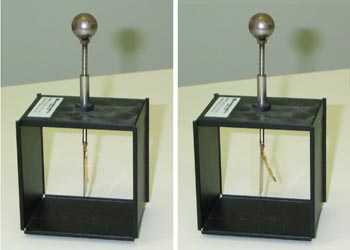The Electroscope
The electroscope was an early instrument used for
- detecting charge on
bodies
- identifying the sign
of the charge
- roughly estimating
the amount of charge on a body.
It was used a good deal in the early days to discover the
qualitative concepts about electric charges that we have discussed so
far.
 The
main part of an electroscope is a very thin, very light, metal foil,
often made of gold, that hangs from the bottom of a metal rod, next
to a piece of metal. (Sometimes one can also see electroscopes that
have a pair of metal foils.) The upper end of the metal rod
terminates in a cap. The rod is enclosed in a metal box, through an
insulating stopper, keeping the cap outside. The bodies to be tested
are brought near the cap. Two of the sides of the metal box have
glass windows, so that one can see what is happening to the metal
foils (also called leaves). The metal box is grounded, i.e. connected
to the Earth.
The
main part of an electroscope is a very thin, very light, metal foil,
often made of gold, that hangs from the bottom of a metal rod, next
to a piece of metal. (Sometimes one can also see electroscopes that
have a pair of metal foils.) The upper end of the metal rod
terminates in a cap. The rod is enclosed in a metal box, through an
insulating stopper, keeping the cap outside. The bodies to be tested
are brought near the cap. Two of the sides of the metal box have
glass windows, so that one can see what is happening to the metal
foils (also called leaves). The metal box is grounded, i.e. connected
to the Earth.
In the picture on the left you can see an electroscope that is
typically used in our introductory physics lecture demonstration
setup. On the left is is uncharged, and on the right a very minute
amount of charge has been put on it. You can see that in this case
the gold foil pulls away from the metal plate. Why this repulsion?
This is the next topic...
©
MultiMedia Physics
2000
 The
main part of an electroscope is a very thin, very light, metal foil,
often made of gold, that hangs from the bottom of a metal rod, next
to a piece of metal. (Sometimes one can also see electroscopes that
have a pair of metal foils.) The upper end of the metal rod
terminates in a cap. The rod is enclosed in a metal box, through an
insulating stopper, keeping the cap outside. The bodies to be tested
are brought near the cap. Two of the sides of the metal box have
glass windows, so that one can see what is happening to the metal
foils (also called leaves). The metal box is grounded, i.e. connected
to the Earth.
The
main part of an electroscope is a very thin, very light, metal foil,
often made of gold, that hangs from the bottom of a metal rod, next
to a piece of metal. (Sometimes one can also see electroscopes that
have a pair of metal foils.) The upper end of the metal rod
terminates in a cap. The rod is enclosed in a metal box, through an
insulating stopper, keeping the cap outside. The bodies to be tested
are brought near the cap. Two of the sides of the metal box have
glass windows, so that one can see what is happening to the metal
foils (also called leaves). The metal box is grounded, i.e. connected
to the Earth.